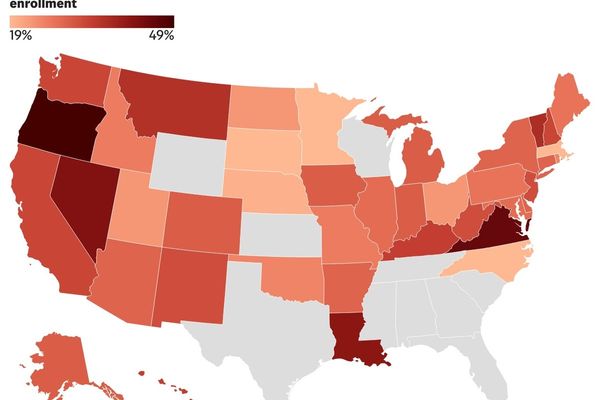The CPI inflation rate continued to pull back from a 40-year peak in August, but less than expected. Core inflation, which strips out food and energy prices, unexpectedly reaccelerated from July's tamer pace. Following the CPI report, which cinches a big Fed rate hike next week, the Dow Jones industrial average turned sharply lower in Tuesday stock market action.
The CPI inflation rate eased to 8.3%, retreating from July's 8.5% and June's 9.1% rate, amid falling gas prices. The consumer price index rose 0.1% on the month. But Wall Street economists had expected the CPI to show a 0.1% monthly decline, bringing the CPI inflation rate down to 8%.
The core CPI rose 0.6% from July. Economists had expected the monthly increase to match July's 0.3% rise. The annual core inflation rate rose to 6.3% from 5.9% in July. March's 6.5% core inflation rate was the highest since August 1982.
A hotter-than-expected reading on core inflation will keep pressure on the Fed to hike its key interest rate 75 basis points for a third-straight meeting, with a decent chance of 100 basis points. Even worse for the Dow Jones and broader stock market, Wall Street is now pricing in a rise in the Fed's key rate to a range of 4%-4.25% by the end of 2022. Prior to the CPI report, markets had expected the Fed rate to peak at 3.75%-4%. Now, odds are roughly even that the Fed may lift its target range to 4.25%-4.5% in 2023.
Biden Approval Rating Gets Big Bounce From Young Americans
Goods Vs. Services Spending
Inflation in goods prices, excluding food and energy, has decelerated from double-digit increases earlier in the year. But that progress paused in August. Core goods prices rose 0.5% on the month and 7.1% from a year ago, a tick up from July's 7% increase.
Inflation in nonenergy services prices, which affects 56% of consumer budgets, has yet to subside, rising 0.6% on the month and 6.1% from a year ago, vs 5.5% in July. The annual increase was the highest since February 1991.
Take Our Anonymous Survey And Tell Us What You Like (And Don't Like)
Until inflation begins to ebb for this category of spending, which includes rent, medical services, transportation and education, the Fed may not be convinced that inflation pressures are easing. That's because price increases for such services are closely linked to the tight job market and high wage growth. If wages weren't rising more than 5%, big price increases would hurt demand and balance out markets.
The August jobs report saw some improvement in labor force participation, lifting the unemployment rate to 3.7%, despite solid job growth. More of the same could begin to ease wage pressures, but at the moment, the labor market remains much too tight for the Fed.
Dow Jones Reaction To CPI Report
The Dow Jones tumbled 3.9%. The S&P 500 slumped 4.3% and the Nasdaq composite 5.2%.
Stocks had been trying to fight back from their walloping after Fed chief Powell's Aug. 26 speech in Jackson Hole, Wyo. Powell's terse remarks focused on the Fed's mistakes from the 1970s, which fueled double-digit inflation. He signaled that policymakers will keep interest rates higher for longer to avoid a repeat, casting doubt on a pivot to rate-cutting in 2023.
The 10-year Treasury yield rose 6 basis points to 3.42%, a three-month high. That's closing on the 11-year high of 3.48% set on June 14.
CPI Inflation Report Details
Prices for used cars and trucks fell 0.1% on the month. But new vehicle prices rose 0.8% from July and 10.1% from a year ago.
Energy prices fell 5% on the month, but increased 23.8% from a year ago.
Prices for food away from home rose 0.9% in August and 8% from a year ago. Prices for food consumed at home climbed 0.7% last month and 13.5% over the past year.
The rent index rose 0.7%, as did owner's equivalent rent. Their respective annual increases of 6.3% and 6.6% are the largest since 1986.
Prices for transportation rose 0.5% on the month and 11.3% from a year ago. Medical services prices rose 0.8% from July and 5.6% from August 2021.
Fed Focused On Core Inflation
"Core inflation is a better predictor of inflation," Fed chief Jerome Powell said in his July 27 news conference.
In prior months, when oil and gas prices were surging, the Fed focused on headline inflation. But now that gas prices are falling, the Fed's tune has changed. Core prices are again the focus, which is a return to normal.
Usually, Powell explained, policymakers can look through a short-term jump in prices of commodities like oil. But inflation has been too high for too long, so there's increased risk that households will begin to expect higher inflation in the future. That can lead to behavioral shifts, like more aggressive bargaining for wage hikes and increased spending — before prices rise further.
In other words, headline inflation only matters when it's bad for an extended period, like in the first half of 2022. So if oil prices start to rise again, the focus may again shift.







